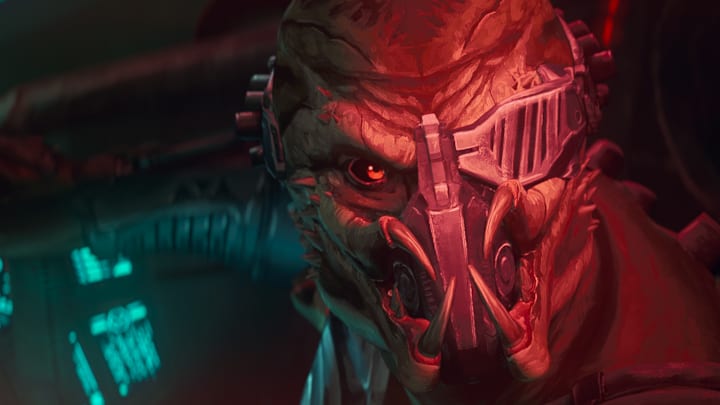After 2018's The Predator, these Predator movies sure did seem dead and buried. However, a lot has changed in seven years. While some of us took up new hobbies or became more interested in certain sociopolitical causes, the Predator films used that time to get the creative juices flowing again. For so long, it seems inevitable that there would never be a worthy follow-up to 1997's Predator. Then Prey came along and shattered all expectations.
Now, Prey director Dan Trachtenberg has once again zigged when everyone expected him to zag. For the next step of the Predator saga, he and fellow director Josh Wassung have helmed an animated anthology film entitled Predator: Killer of Killers.
The conceit here is building upon Prey’s exciting period piece setting through telling a trio of tales set in wildly varying eras of human history. First in this collection of violent narratives is is Viking legend Ursa (Lindsay LaVanchy) taking her son Anders (Damien Haas) and several loyal warriors out for revenge against the man she holds responsible for her father's death. Next is an almost exclusively silent yarn set in Japan's Edo period in 1629. This tale concerns two formerly tight-knit brothers who instantly grew apart during a training session as youngsters. Now, the isolated sibling, now an adult and a ninja, comes back for revenge the same night a Predator alien descends on the premises.
Finally, there’s the 1941 story of Torres (Rick Gonzalez), an American mechanic recruited into World War II. Stuck on an aircraft carrier, he’s desperate to get his plane working and prove himself as a soldier to his superior (voiced by Michael Biehn). Unfortunately, a seemingly ordinary day gets disrupted when Torres realizes his squad members are getting picked off in the sky by an otherworldly hunter.
Screenwriter Micho Robert Rutare interestingly makes the Predator aliens often incidental to the individual plots of Killer of Killers. Anyone yearning to check this title out to see Predator’s slicing humans in half or deploying those nets that squeeze any object into a million pieces will get their money’s worth. Happily, though, there are concrete and reasonably engaging storylines going on here for protagonists like Freya and Torres. Predators are treated as obstacles to their goals or emotional fulfillment. Rutare and Trachtenberg don’t just abandon parables about brotherly strife or the cost of vengeance once the big hulking aliens show up.
In terms of action, though, Killer of Killers delivers. Happily, the fight scenes nicely vary depending on the time periods of each story. The final chapter focusing on Torres, for instance, gets a lot of mileage out of uniquely grisly dogfights. Like classic adventure films from this era (or even later period pieces set in the era like The Rocketeer), there’s triumphant joy in any fleeting victories. That’s a sharp contrast to the opening segment’s ominous tone rooted in the innate hollowness of revenge missions. That atmospheric quality also comes from the strikingly brutal hand-to-hand combat vividly capturing the relentless viciousness of Viking existence.
In terms of raw fight choreography, Killer of Killers has lots satisfying set pieces. Deploying dexterity on how those skirmishes manifest, though, keeps the proceedings from melting into monotony. Trachtenberg, here helming his first animated film, clearly relishes the visual possibilities in realizing fight scenes unbound by the weight of physical cameras. With total control over the various digital realms, the two Killers directors, not to mention the features editing team, realize the assorted gory fight scenes with crisp precision. Viewers can fully witness every chopped-off head and appendage with no shaky-cam getting in the way.
Less successful visually is the animation style. The Third Floor's animation team is competent in terms of character movement as well as creating surfaces that look worn and weary. Incorporating hand-drawn-animated puffs of smoke and explosions is also a welcome touch. However, the human characters always appear a tad off, especially whenever they’re caught in bright sunlight. The default character designs of Killer of Killers are like the offspring of Nimona’s populace mixed with the mannequin-esque Clone Wars humans. Additionally, elements like bushy beards or water never quite look right.
There are still tremendously evocative images throughout Killer of Killers in terms of blocking and lighting. The various Predators (each segment has a radically different cosmic adversary) also fare much better from a design standpoint. However, leaning heavily on close-up shots for heavy dramatic moments just constantly reminded me of distractingly subpar qualities in those rubbery human faces. Those ambitious, dramatic impulses exceed the grasp of Predator’s animation. Killer of Killers isn’t afraid to incorporate stylized and even occasionally impressionistic qualities into its backgrounds and props. This saga’s flesh-and-blood Earthlings, though, look artificial in all the wrong ways.
Benjamin Wallfisch's Killer of Killers score also leaves something to be desired. Specifically, his tracks fail to exploit all the wildly varying sonic possibilities of each time period. The first and second stories especially have frustratingly interchangeable music sensibilities. Only in the third segment does Wallfisch embrace something new by sprinkling in auditory impulses reminiscent of old-school adventure movie scores. While the script and camerawork work overtime to give each vignette a distinctive aura, Wallfisch's score tends to go through the motion.
Even with those visual and auditory shortcomings, Predator: Killer of Killers is a commendably entertaining outing. Even extended set pieces totally devoid of action, like a sequence chronicling a ninja trying to subdue guards before they ring a warning bell, are transfixing and fun creations. Once the camera focuses exclusively on master human warriors duking it out with vicious cosmic combatants, things get even more entertaining. Most intriguingly, Trachtenberg's gift for realizing maximalsit grisly carnage co-exists with a welcome recurring narrative fascination with human beings emphasizing unity and co-operation, not endless vengeance. Who could’ve imagined something this thematically audacious and constantly fun emerging from the Predator saga after 2018’s The Predator?
